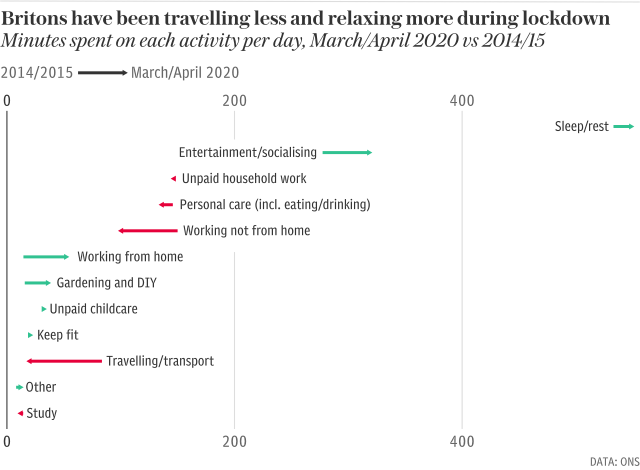Revealed: How Britons are turning lockdown into a life of leisure


Britons have used their newfound extra time saved from not commuting to the office by indulging in hours more sleep, television and gardening, official figures reveal for the first time.
New Office for National Statistics (ONS) data reveals how life has changed under lockdown.
Researchers asked people how they were spending their newfound free time and divided up their answers into the following categories: sleep and rest, entertainment, socialising and other free time, paid work, unpaid household work excluding travel and childcare, personal care including eating and drinking, working from home, gardening and DIY, unpaid childcare, keeping fit, travelling and transport and studying.
They found that people increased the time they spent on entertainment, socialising and other free time by 44 minutes a day.
However by far the most popular activity in this broad category was watching television or streaming videos, which took up 2 hours and 53 minutes a day on average.

Other activities in this category were far less popular: we spent 28 minutes a day reading, 26 minutes playing games (including computer games), and 16 minutes a day contacting friends and family via phone or messaging services.
There was also a substantial increase in the time spent gardening and doing DIY by 147% to 39 minutes a day, and on average we spent an extra 18 minutes sleeping or resting.
During lockdown, there was also a fall of 1 hour and 24 minutes a week in the time spent eating, drinking and engaging in activities such as getting ready to go out; going to cafés, pubs, restaurants; and getting a haircut.
Instead, Britons spent 1 hour and 23 minutes a day eating and drinking, which includes eating takeaway food and drinking alcohol, and just under an hour a day cooking or doing the washing up.
However the research also reveals that not all Britons are experiencing lockdown in the same way.
Researchers found that people with low household incomes have been spending more time doing paid work since the lockdown began.
Those with monthly household incomes up to £1,700 have spent an extra 21 minutes a day on average doing paid work, compared with a drop of around 32 minutes for those on monthly incomes of £1,700 to £3,300.
The figures come from a survey compiled by the ONS, which examines various aspects of life in Britain during March 28 to April 26 2020 and contrasts it with data for 2014/15.
The ONS said the increase in working time for people on low household incomes could be because they are more likely to be in jobs that cannot be undertaken from home and have had to continue going into work during the lockdown.

Gueorguie Vassilev, senior research officer at the ONS, said: "These new findings show that not all households are experiencing the impacts of the coronavirus pandemic in the same way.
"It will be interesting to see if time use reverts to a pre-pandemic pattern after this crisis is over, or if some changes will be lasting ones."
The data also shows that men are doing more than an hour less unpaid labour than women each day, despite increasing their responsibilities during the coronavirus lockdown.
Time spent on childcare has risen by more than a third (35%) during the lockdown, while care from older people such as grandparents has plummeted by 90%.
Men increased their unpaid labour, such as caring for children or adults, housework and volunteering, by 22 minutes to two hours and 25 minutes a day, the study found.
However while women's burden was reduced by 20 minutes a day, to three hours and 32 minutes, they are still giving one hour and seven minutes more of their time than men.
The Time Use survey compared data from March 28 to April 26 with figures from the previous study between April 2014 and December 2015.


